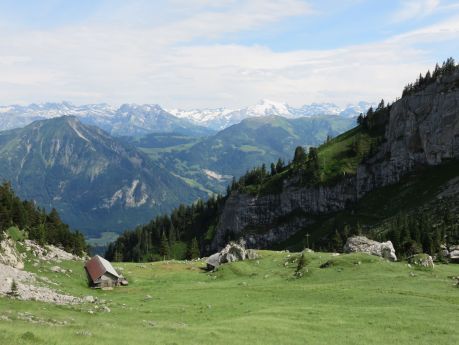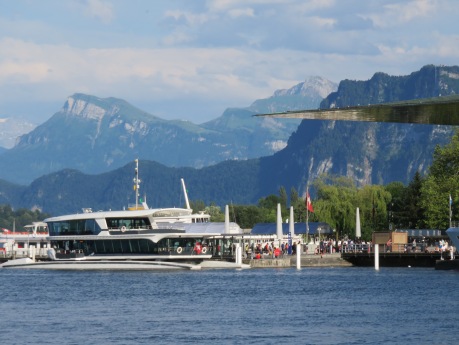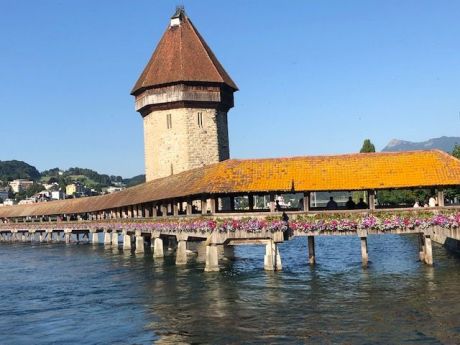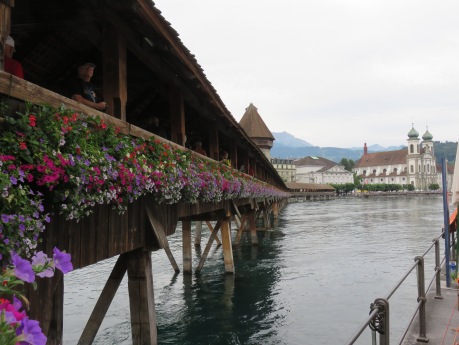Part 1: ALPINE ADVENTURES EXCEED EXPECTATIONS – LUCERNE
It was the trains that did it.
The idea of trains snaking slowly up to mountain peaks 7,000 feet or higher along ancient cogwheel tracks exhilarated my any-excuse-to-take-a-train husband, Russ. My stomach roiled pondering multiple train rides chugging along steep inclines, thinking about how I got nervous even holding onto the railing on the Empire State Building’s upper floor and tried looking down. He buttered me up about taking the Odysseys Unlimited Alpine Splendor tour by painting a picture of the scenic beauty we’d encounter in five countries: Switzerland, Austria, Italy, Liechtenstein, and Germany. By then, I remembered we’ve climbed glaciers and volcanos, ridden cable cars up 5,000 feet, and never once did I pass out in fright. My fears morphed into anticipation.
Ride along with me on this soaring Alpine Adventure which concluded with an extension trip toMunich, Germany. Along the way, we’ll take cogwheel trains, gondolas, funiculars, and gentle coastal boat rides to experience the natural breathtaking beauty that can be inspirationally exhilarating and simultaneously calming.
We arrived in Zurich, but the trip actually began in Lucerne (Luzern), Switzerland.
Lucerne (Luzern)
On a clear day even in summer, Lucerne is a city of contrasts. Lake Lucerne’s royal blue water laps against a shoreline of both contemporary and ancient architecture, while visible to the naked eye are snow-capped mountains. In the city center is one of Europe’s oldest covered bridges. Twice weekly a 500-year-old farmer’s market in Old Town still entices. Yet, this is also a city of modern pleasures, such as casinos, concerts and multiple art galleries. The city is the capital of the canton of Lucerne, home to roughly 81,000 people who speak a Swiss-influenced German. Since the 1950s, tourism has boosted its profit margins.
Where we stayed:
Renaissance Lucerne Hotel is centrally located to the train station and Old Town. The rooms are pleasant, the staff efficient, but it is their South American-styled restaurant Pacifico that solidifies my praise. Wooden beams, Spanish-themed murals of flamenco dancers, musicians and landscapes enliven the walls. Red-coned shades hang from crystal chandeliers, emitting ambient soft lights even over the extensive breakfast buffet. At night, the room transforms into a party, with bands, dancing and a Latin menu.
What we saw:
One of the city’s most iconic attractions is the Lion Monument, a memorial carved in stone in 1823 and dedicated to the Swiss Guard forces killed during the 1792 French Revolution uprising. The lion is clearly suffering, a look of anguish plastered on its drooping face as it sags on two shields, one bearing the Swiss cross and the other the Bourbon coat of arms. The words written above the lion means Switzerland is couragous and virtuous.
The Swiss love festivals, such as one honoring cows. They aren’t sacred as they are in India, but they are definitely celebrated in Switzerland with two yearly festivals. The first is in the spring when they are herded to the alps for summer and the second happens each fall when they’re returned before the snows fall. One cow is crowned queen of the herd, receiving a display of flowers around her head. It’s a colorful festival, enhanced by partiers attired in native costumes.
Carnivale is a fun family festival held after Lent, similar to Mardi Gras in New Orleans, Louisiana or Carnivale in Rio de Janeiro, Brazil. A fanciful fountain symbolizing the annual festival is based on a legendary 15th century character whose body is allegedly buried under the fountain. Built in a neo-Renaissance style in 1918, Fritschi Fountain features painted figures of Fritschi and his wife Fritchine. A maid and a peasant sit on top. Four fools’ masks pump water from goats’ horns into the hexagonal trough. The Spreuer Bridge, also called the Chaff Bridge, is one of Europe’s oldest covered bridges. When first erected in 1331, it was built as part of a fortification in the battle against the Hapsburgs. Due to its downriver location, it was the only bridge in the city where it was legal to dump chaff (Spreu; hence Spreuerbrücke) and leaves into the river. It was flooded in 1566 and later a fire took its toll. The 700-foot long bridge spans across the wide, usually calm, River Reuss, connecting Old Town to more modern sections of the city. It is under the bridge’s ceiling that the bridge’s dramatic identity is realized by 67 paintings in the Dance of Death series done by Kaspar Meglinger, painted between 1626 and 1635. The series reminds people to be good, while indicating that death doesn’t differentiate between ages, religions or wealth. The style of paintings, popular across medieval Europe, were often placed on cemetery walls, but the ones preserved under the bridge roof are some of the finest existing examples.
Hotel des Balances wasn’t always a hotel. It’s a beautiful building with elaborate frescoed exterior walls and where people originally went to dispute prices or weights.
There are nine towers in Lucerne, but only the Zyt Tower features a still-functioning clock. Though the tower’s walls date back to 1386, Hans Luter built the large clock in 1535. The hour chimes one minute before all other clocks in Lucerne.
One of the highlights of visiting Lucerne, other than meeting up with a dear longtime friend, Kurt Willimann (who was born there), was getting to ride our first cogwheel train to the top of the 7,000-foot high Mount Pilatus, a multi-peaked massif that oversees Lucerne and Central Switzerland. We were scheduled to then take two consecutive gondolas down the other side. The cogwheel train was built in 1889. The steepest grade is 48%. Our illustrious Tour Guide, Chris, told us legends about the mountain as we chugged upward, such as there were once dragons with healing powers who lived in the nooks and crannies of the mountain. How people witnessed the dragons, were healed or killed, remains the stuff of lore that you’ll just have to explore for yourself. We also heard that in 1868, Queen Victoria scaled Mount Pilatus on a mule. Not many years later, in 1890, the mountaintop lodging known as Pilatus Kulm was built. Renovated in 2010, the historic 30-room property offers 360-degree views of the surrounding mountains and valleys.
Our train ride up Mount Pilatus began easily enough. We passed cows dangling large bells around their necks as they grazed. Fields of bright wildflowers became alpine flowers the higher we climbed. The steep ascent quickly morphed into the scariest, thrill ride of our tour. Here’s what happened.
I was already holding my breath that the train would continue its successful history of reaching the station when out of nowhere, hurricane-like force winds and pounding rain thrashed our cars. I’m a Florida woman. I know what hurricane force winds are like. We did arrive safely, but after several pointless minutes of gazing out windows and seeing nothing but a raging storm, an announcement came over the station speakers that all gondola rides were cancelled. Our descent would be on the cogwheel trains. Hundreds of people anxious to depart rushed for the train queue. I’d love to say it was orderly, but it wasn’t. Our group waited at least an hour to board for the downward trip.
Later that day, we discovered this had been a freak storm gusting up to 85 mph that blew across Switzerland, ravaging trees and buildings in its wake. The wind crashed trees into gondolas. Some people were trapped for hours until they could be rescued. We were safe, but what a memorable experience to begin the two-week tour.
We walked by the Schweizerhof Hotel, which fronts Lake Lucerne. Composer Richard Wagner stayed there and wrote the opera Tristan & Isolde there.
In 1666 the Jesuit Church of Lucerne resembled a palace rather than an austere church. We marveled at the crystal chandeliers and the intricate marquetry done in various colors of marble that comprise all the church’s side chapels. Located directly across from the Chapel Bridge, this was the first large Baroque church built in Switzerland. It was consecrated in 1677.
What we learned:
One of many advantages to an Odysseys Unlimited tour is that our motor coach drivers are from the respective region and experienced with the roadway curves and rules. Our driver this time was the multi-lingual Klaus from Salzburg, Austria (where our official tour would end). Not only was he pleasant and professional, but the Eschbacher-owned coach is the nicest one in which I’ve ever ridden. The seats reclined. The AC worked and you could individually control the output over your seat. The sound system didn’t cackle like a squawking chicken when Chris played us music to accompany the sights, regaled us with witty legends or historical data, or taught us useful phrases, such as Greutze (Good morning) and Wie geht’s (How’s it going?) The back end of the coach had a table with cup holders surrounded by at least six lounge chairs.
There are four official languages in Switzerland: French, German, Italian and Romansch. 60% of Switzerland speak a Swiss-German variant. Romansch is spoken by about 70,000. Chris said it sounds like Italian spoken with a heavy German accent.
The oldest city in this naturally-scenic country is now called Chur. It was first settled in 11,000 BC. What further cements its historic significance is that over time, the area came to be ruled by Bishops. By the 4th century, their power waned. Rich nobles became the new religious and land leaders, titled Bishop Princes. Thus, they were able to collect taxes and become even wealthier.
The opening of the Gotthard Pass in 1220 put Lucerne on the map. When once a simple fishing village, it was now a commerce center, enabling traffic flow across the mountains from Italy.
There are four cantons around Lake Lucerne.
Switzerland has the highest wage in world. Roughly 22 Francs (and $22.20 USD) an hour. Business taxes are low. For the first year of unemployment, people earn 70% of their employment wage, capped off at $10,000 a month. Swiss people who earn money outside the country do not pay Swiss taxes.
The country hasn’t been to war since 1515 even though they still maintain an army that once numbered 15,000 and were often hired as mercenaries. All men must enlist in the army, starting in their 20s for training. They remain until age 42. Might be called up every few years for a few weeks at a time. Although the country maintains its neutral position, it has the most weaponry per capita in the world. Women can voluntarily join.
1386 – Switzerland won independence from the Habsburgs.
Switzerland is officially known by the Latin name “Confoederatio Helvetica” (Swiss Confederation in English) for historical reasons. Confoederatio (confederation) and Helvetica refers to the Helvetians, a Celtic tribe who lived in Switzerland during the Romans invasion. The country has actually been a federation since 1848 when it limited the power of the cantons. The international abbreviation of Switzerland is CH, for Confoederatio Helvetica.
Victorinox is the only company that makes authentic Swiss Army knives.
1861 was first time the Red Cross aided in a war. They needed a flag to identify their staff. Improvising, they reversed the square-shaped Swiss war flag colors, which became the Red Cross symbol.
The Bourbaki-Panorama contains one of the last-known enormous panoramic paintings of the 19th century that has been preserved. Edouard Castres, who survived the German-French war of 1870-1871 as a Red Cross volunteer, painted it as a commentary on the devastation war causes.
Jean Henri Durant organized the Geneva Convention. He was the first recipient of the Nobel peace prize.
The Swiss are known for precision. That reputation evolved over time. At first they manufactured watches, clocks and lace as cottage industries because they were stuck inside during harsh winters but needed to produce. Those products were then brought into shops to sell. Bucherer, the most famous watch store in Lucerne, originated in the city. The company now has stores in many countries.
River Reuss’ mountain waters flow fast North to the Rhine River.
About 60% of Switzerland esidents are reputed to be religiously Catholic. My Swiss friend, Kurt, thinks it more like 40% Catholic, 40% Protestant and 20% others.
For more than 500 years, the Lucerne farmer’s market has sold cheeses, breads, sausages, plants and flowers every Tuesday and Saturday until noon.
The canton of Lucerne’s blue and white flag hangs on the Town Hall, built in 1606 in Renaissance style.
Bern is the capital of the country. There are 26 cantons, each with autonomy for education, taxes, rules etc.
Shops close by 4 on Saturdays and are closed on Sunday across the country except in really touristy areas. No cars are allowed in the Old Town on weekends except for delivery trucks, and then only until 11.
Pharmacies always have a green cross outside, unlike other countries which use a red cross.
An ironwork pretzel symbol indicates a bakery, except here they are called bretzel. The symbol represents the Trinity and crossed arms. Pretzels have been around for almost 1,400 years. History has their origin about A.D. 610 when a baker in a French or Italian (they each claim credit) monastery twisted leftover strips of bread dough into the shape of a person’s arms crossed in prayer. Monks began offering the warm, doughy treats known as pretiolas (little rewards) to children who had memorized their Bible verses and recited prayers, and to educate them about the Christian Trinity of Father, Son and Holy Ghost.
The legend of William Tell is strong in Switzerland. Story goes that Habsburg Bailiff Albrecht Gessler had the power to tax people. In each city he visited, he’d prop one of his hats on a pole as a symbol of his power. He expected people to tip their hats towards the pole as a sign of respect to both him and his position. Tell refused and was arrested. Gessler, aware of the archer’s reputation with a crossbow, then allegedly took Tell’s son, placed an apple on his head, and said if Tell knocked the apple off, both he and his son would be set free. Tell had two arrows in his quiver. With the first, he knocked off the apple. Gessler asked why Tell had the second arrow. Tell replied he’d use it to kill Gessler if the first arrow accidentally killed his son.
Furious, Gessler had two henchmen re-arrest Tell. While taking him to jail in a boat, a violent storm arose. Tell was untied to help get the boat ashore. He jumped off, grabbed his crossbow, and slayed the two men. Where he landed is now marked by a rock called Tellsplatte. It has become a symbol for the Swiss attributes of independence and resistance. Tell later ambushed Gessler and slew him as well. Tell’s star status grew after Friedrich Schiller wrote a book in 1804 about the incidents. That book inspired Gioachino Rossini, who composed the opera, “William Tell’s Overture.”
Where and What we ate and drank:
Our welcome to Switzerland meal at Restaurant Schiff was indeed welcoming. We sat cozily in a small upstairs private room, the windows open as the night air was still humid from the day’s unexpected heat. Family-styled platters of local mountain cheeses, air dried sausages, ham, dense breads and olives were laid across the table. Ramekins of butter, olive oil with pumpkin seeds, and another with caraway seeds accompanied them. Between the heat and being in an area where white wines reign supreme, we forewent our usual preference for red wines and chose the Cuvee Quintett by Toni Ottiger, composed of chardonnay, pinot gris, Gewürztraminer, Müller-Thurgaum and Seyval. Tartly aromatic. The blend worked well with our meal. Menu options were roulade of beef stuffed with onion, bacon and gherkin, poached fillet of a local white fish dotted with a white wine and herb sauce, or sliced Swiss chicken breast “Zurich style”, which meant that the soft chicken and potato chunks liberally bathed in a creamy mushroom sauce. Russ and I both chose the latter. The dish was filling and hit all the right notes for comfort food. I almost didn’t have room to even taste the Caramelköpfli, a mocha-colored caramel flan.
Kurt took us to lunch at Wirtshaus Galliker, a restaurant built in 1681 and turned into a restaurant in 1880. It has been owned by successive generations of the current family since 1856. Kurt knows the family as he grew up literally around the corner and has frequented the restaurant since then. We ordered Luzerner Chügelipastete, a traditional Lucerne dish of small balls of veal slowly cooked in a creamy mushroom sauce and served in-and-over a puffed pastry shell. Other signature dishes of the city are tripe and veal head, which we were happy Kurt had not recommended. Our lunch was accompanied by wonderfully dense brown sourdough bread. Amazing flavors.

Traditional Lucerne dish of small balls of veal served in a puffed pastry shell at Wirtshaus Galliker
That evening, Kurt brought us to Restaurant Olivo Luzern on the top floor of Grand Casino Luzern. We sat on the balcony overlooking the very picturesque serenity of Lake Lucerne, the pre-Alps and Mount Pilatus. This was fine dining in an elegant atmosphere. Unfortunately, that evening, the service was terribly slow by an uninterested staff. We drank champagne while waiting for my fresh tomato roll and the pretzel rolls Kurt and Russ had. I thoroughly enjoyed a thick Andalusian-styled gazpacho soup along with a langoustine bruschetta. Kurt had a pureed eggplant soup adorned by broiled yellow and orange cherry tomato halves. Russ’ salad was piled up high like a pyramid, with small savory bites peeking out.
My entrée was artistically-plated pieces of perfectly-cooked turbo, accompanied by a colorful splash of pureed veggies dotting the plate. Kurt had a risotto with duck liver and Russ had spaetzle (noodles) with roast pork. We absolutely could only rave about the quality of our meal. Our only issue was the hour-and-a-half delay between the soup and the entrée, with no one on the staff wanting to accept responsibility.
In Part 2: A boat and train rides guide us to Zermatt, an alpine skiing town at the base of the Matterhorn.
Karen Kuzsel is a writer-editor based in the Orlando area who specializes in the hospitality, entertainment, meetings & events industries. She is an active member of ILEA and MPI and is now serving on the 2019 – 2020 MPI Global Advisory Board for The Meeting Professional Magazine for the fourth consecutive year. She is a member of the Society of Professional Journalists. Karen writes about food & wine, spas, destinations, venues, meetings & events. A career journalist, she has owned magazines, written for newspapers, trade publications, radio and TV. As her alter-ego, Natasha, The Psychic Lady, she is a featured entertainer for corporate and social events. karenkuzsel@earthlink.net; www.ThePsychicLady.com; @karenkuzsel; @thepsychiclady. Food photos for this series by Karen Kuzsel. All other Photos by Russ Wagner, a retired government planner/builder who has a passion for trains, travel and taking photographs.
www.marriott.com/hotels/travel/emlbr-renaissance-lucerne-hotel/




















Trackbacks & Pingbacks
[…] *ALPINE ADVENTURES EXCEED EXPECTATIONS, https://karenkuzsel.com/2019/09/23/part-1-alpine-adventures-exceed-expectations-lucerne/ […]
Leave a Reply
Want to join the discussion?Feel free to contribute!